Культура и традиции стран изучаемого языка
31
Министерство образования и науки Российской Федерации
Федеральное агентство по образованию
Государственное образовательное учреждение
высшего профессионального образования
«Комсомольский-на-Амуре государственный технический университет»
Кафедра «Общий и профессиональный английский язык»
Методические указания по английскому языку
для студентов 2-го курса
всех специальностей
Комсомольск-на-Амуре
2011
Культура и традиции стран изучаемого языка : методические указания по английскому языку для студентов 2-го курса всех специальностей / сост. : Т. А. Ромашкина, Л. Д. Шалимова. – Комсомольск-на-Амуре : ГОУВПО «КнАГТУ», 2011. – 31 с.
Цель
методических указаний – развитие
языковой компетенции по страноведению
англоязычных государств.
Печатается по постановлению редакционно-издательского совета ГОУВПО «Комсомольский-на-Амуре государственный технический университет».
Согласовано с отделом менеджмента качества
Рецензент Е. А. Першина
Редактор А. Г. Князева
Подписано в печать 17.12.2010.
Формат 60 84 1/16. Бумага писчая. Ризограф RISO RZ 370ер.
Усл. печ. л. 1,86. Уч.-изд. л. 1,80. Тираж 100. Заказ 23725.
Редакционно-издательский отдел Государственного образовательного
учреждения высшего профессионального образования
«Комсомольский-на-Амуре государственный технический университет»
681013,
Комсомольск-на-Амуре, пр.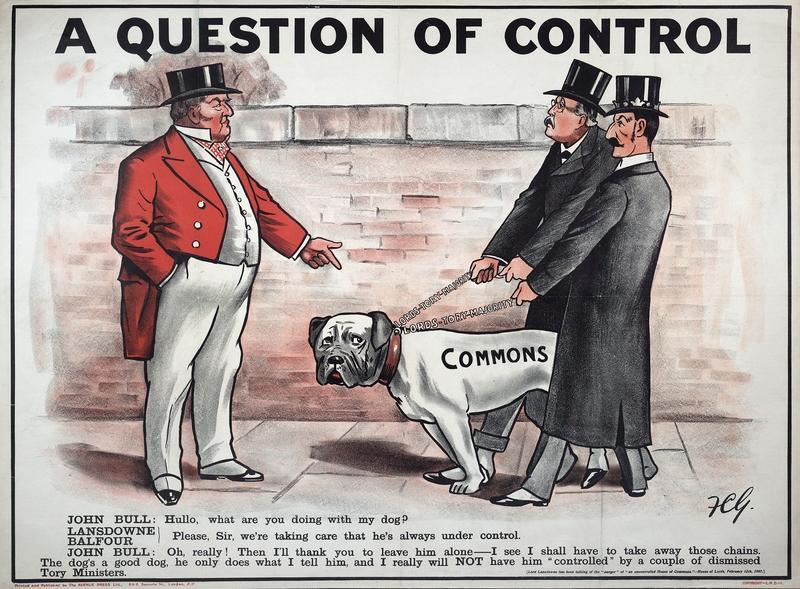 Ленина, 27.
Ленина, 27.
Полиграфическая лаборатория Государственного образовательного
учреждения высшего профессионального образования
«Комсомольский-на-Амуре государственный технический университет»
681013, Комсомольск-на-Амуре, пр. Ленина, 27.
Unit I
Study the words:
to picture – изображать, рисовать pipe – трубка
to reply – отвечать rarely – редко, изредка
to relax – расслабляться landscape – пейзаж
traffic jam – пробка, затор waistcoat – жилет
mention – ссылаться на coal-mine – шахта
landmark – межевой столб hard-working – трудолюбивый
1 My
Image of Britain.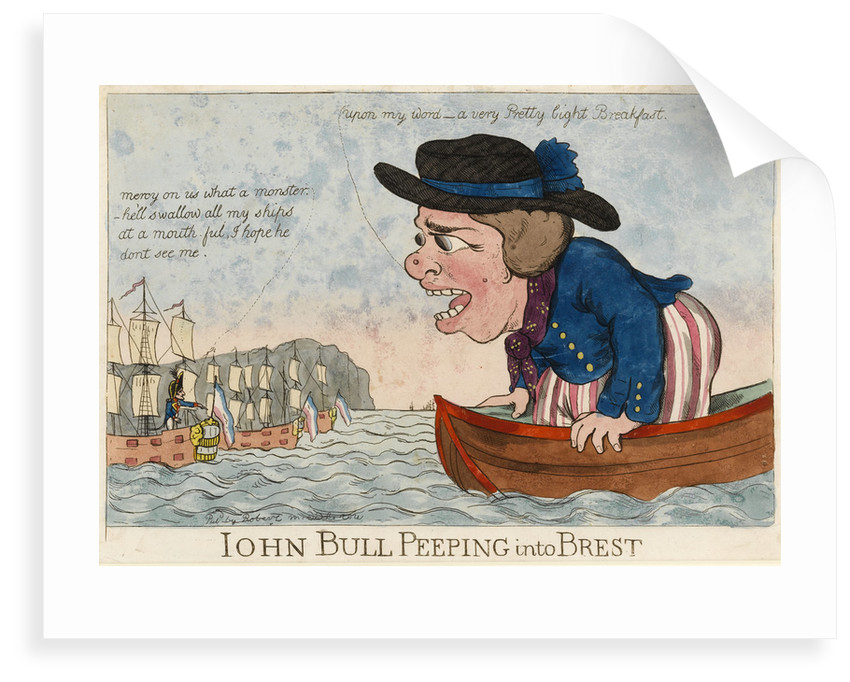
Newspaper and television bring news and opinions from all over the world. From this information we start to build up pictures in our minds of other countries and other people.
2 When people think of a foreign country they picture in their minds different things.
What do you usually think of when you think of a country? (anticipating)
3 Make a list of things. Compare your list with your partner’s.
4 Complete the Word Web.
5 What do you know about Britain?
1) Where is it situated?
2) What are the main countries of the UK and their capitals?
3) What can you tell us about Britain’s climate?
4) Who does the real power in the UK belong to?
5) What are the main industrial centres?
6 The
teenage magazine «Current» asked its readers to give their opinions
of Britain. Here are some of their replies.
Here are some of their replies.
1) Scan the replies to find out if they mention (упоминают) any of the things you mentioned in exercise II. (
2) What other places, people and things are mentioned? (taking notes)
a) Unfortunately when people think of Britain they usually only think of London. If you travel 100 miles (160 km) out of London, it’s as if you are in a different world. The people are kinder, more relaxed, more helpful, the landscape is more beautiful and there’s no traffic jam. Another idea people have of Britain is that the weather is always cold and wet. I think they are correct. The British Isles have never been famous for good weather. (Rob Wilson, 17)
b)
When
I think of Britain, I think of two main areas, Scotland and England.
With Scotland some people associate people, who are heavy drinkers
and smokers. I know it’s not true. I picture them as hard-working in
industries such as steel, coal-mining and shipbuilding.![]()
c) I’ve always had the idea that British people are clever. I know several people from Britain. They are all kind and sympathetic and they work hard at school. From television and books I get another image of the typical Brit. He’s an older man with a pipe in one hand. Perhaps he’s eating fish and chips at a pub or playing darts. I also think of great clubs, bars and parties when I think of Britain. I have never been to Britain but I hope to go someday to find out if any of my impressions are true. (
d)
I
think of Britain as a place with a lot of different types of people.
The only big city that I can picture is London. I imagine the rest of
the country as small towns. There isn’t much to do in the way of
entertainment, that’s why people may read more, or learn to play an
instrument, or write, or do something else than go to a movie.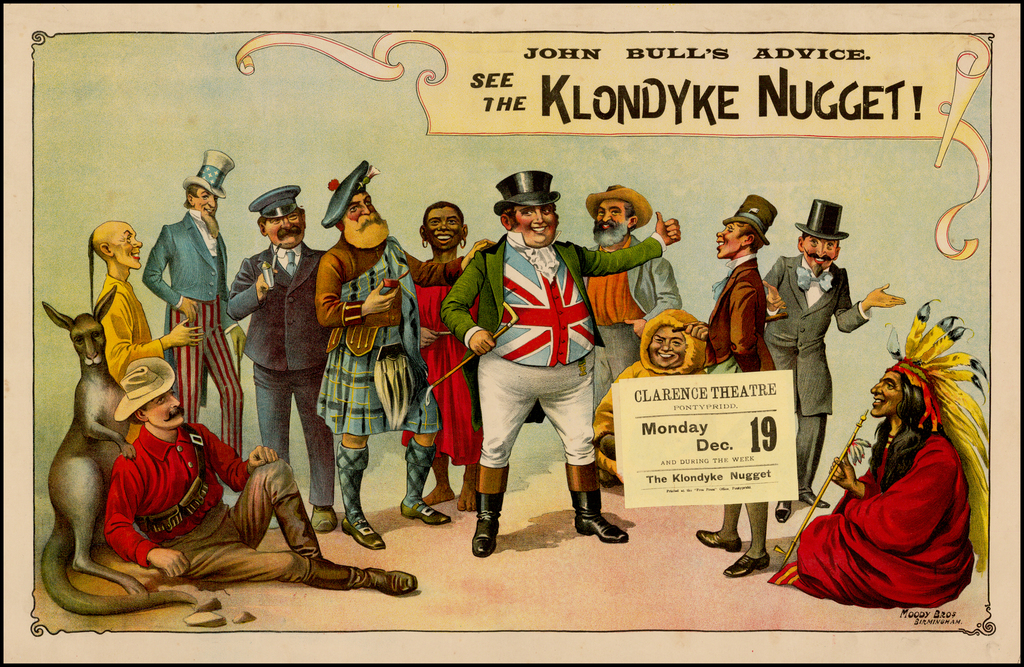
3) Find any point which is mentioned by different teenagers. Is there any contradiction (противоречие) between their opinions?
4) What ideas do these teenagers and other people have of Britain and its people? Do you believe this is true? (expressing doubt)
… says that … I’m not sure if this is right because …
Many people think that … Probably it’s true but I’ve heard/read that …
I don’t think it’s true because …
5) What new facts about Britain and its people have you learned?
7 Countries
often have national symbols or emblems.
John Bull is the symbol of the typical Englishman. He is often drawn in cartoons or picture about England. He was invented in 1712 by a political writer John Arbuthnot. John Bull is drawn as a big man with a large stomach and a round face. He wears high boots, an open jacket and a Union Jack waistcoat. He often has a bulldog with him.
Vocabulary
Union Jack waistcoat – a very colourful waist coat looking like the British Flag (Union Jack). It is usually worn under a jacket.
Union Jack – (also the Union Flag) – the national flag of Great Britain, made up of 3 flags.
1) What other British symbols do you know?
2) What national emblems and colours does your country have?
BRITAIN & THE BRITISH QUIZ
Дата публикации: 28.08.2019 14:15
- Part 1 Choose the correct answer for each question.
a) Uncle Sam
b) John Bull
c) Winston Churchill
2. The capital of Northern Ireland is
The capital of Northern Ireland is
a) Dublin
b) London
c) Belfast
3. The British flag is often called
a) the Union Jack
b) the Stars and Stripes
c) the Maple Leaf
4. Ben Nevis is
a) a famous footballer
b) a sort of whiskey
c) a mountain
5. The national currency of the UK is
a) the euro
b) the dollar
c) the pound
6. The most popular sport in Britain is
a) ice hockey
b) baseball
c) football
7. Britain’s national drink is
a) tea
b) Coca-Cola
c) coffee
8. The mysterious Loch Ness Monster is from
a) Wales
b) Ireland
c) Scotland
9.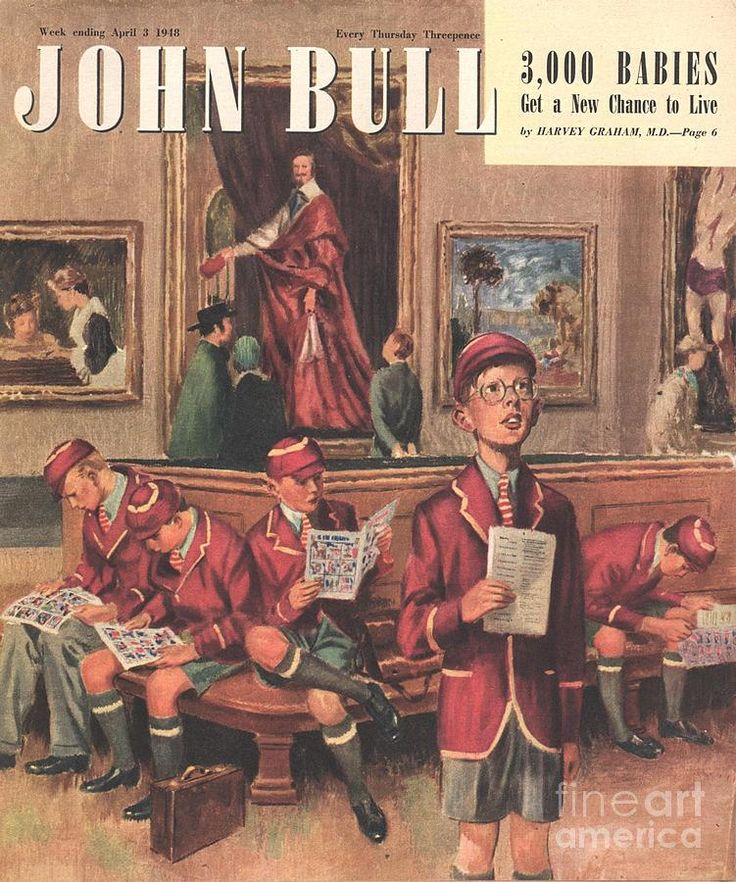 The famous British newspaper which is printed on pink paper is
The famous British newspaper which is printed on pink paper is
a) The Times
b) The Guardian
c) The Financial Times
10. The Beatles started their carrier in
a) London
b) Liverpool
c) Birmingham
11. The kilt is
a) a shirt
b) a skirt
c) a pair of trousers
12. The color that represents Ireland is
a) green
b) red
c) yellow
13. The British football fans _______
a) are the most indifferent fans in the world.
b) are very reserved.
c) have a very bad reputation in Europe for their behavior.
14. Stonehenge is about ______ years old.
a) 40
b) 400
c) 4000
- Part 2 True or false?
The future king of England is called the Prince of Wales.

Walsh is an official language in Wales.
The BBC stands for the ‘Best British Culture.’
A mile is longer than kilometer.
Elizabeth II has two birthdays.
In Britain, black cats are believed to bring bad luck.
Speaker’s Corner is part of the British Parliament.
In Scotland, the name for New Year’s Eve is Hogmanay.
The President of Britain is elected every seven years.
Haggis is a traditional Scottish musical instrument.
A bobby is a guard at the Tower of London.
Shakespeare was born in Stratford-upon-Avon.
Answers:
Part 1
1. b 2.c 3.a 4.c 5.c 6.c 7.a 8.c 9.c 10.b 11.b 12.a 13.c 14.c
b 2.c 3.a 4.c 5.c 6.c 7.a 8.c 9.c 10.b 11.b 12.a 13.c 14.c
Part 2
1.T 2.T 3.F (It stands for British Broadcasting Corporation.) 4.T 5.T (The Queen is the only person in Britain with two birthdays. Her real birthday is on the April 21st , her ‘official’ birthday is on the second Saturday in June) 6.F (Black cats bring good luck.) 7.F (It’s in the Hyde Park. Every Sunday anyone can make a speech to the crowd there.) 8.T 9.F (There’s no President in the UK.) 10.F 9Haggis is a traditional Scottish food make from sheep’s heart, lungs, and liver.) 11.F (It’s a policeman.) 12.T
Джон Булл, символ англичан и английскости
Джон Булл — воображаемая фигура, которая является олицетворением Англии, подобно американскому «дяде Сэму». Он показан в карикатурах и карикатурах как зажиточный фермер 18 века.
Джон Булл впервые появляется как персонаж в серии политических сатир Джона Арбетнота (1667-1735). Арбутнот — шотландский ученый, врач и политический сатирик.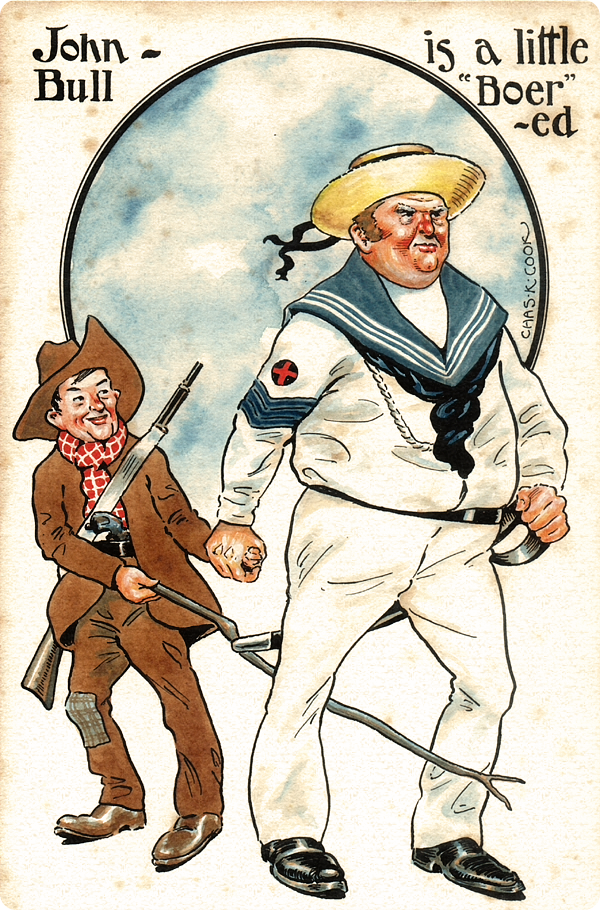 Его серия брошюр о Джоне Булле «История Джона Булля» представила Джона Булля как типичного англичанина: «честного и прямолинейного парня, холерика, смелого и очень непостоянного характера» (с Закон — бездонная яма).
Его серия брошюр о Джоне Булле «История Джона Булля» представила Джона Булля как типичного англичанина: «честного и прямолинейного парня, холерика, смелого и очень непостоянного характера» (с Закон — бездонная яма).
К 1762 году Джеймс Гилрей и другие карикатуристы включили Джона Булля в свои работы, и он появился в виде карикатуры сэра Джона Тенниела в журнале Punch.
Бык обычно изображается как толстяк во фраке, бриджах и жилете с флагом Союза, одетый по моде эпохи Регентства. Он также носит на голове низкую шляпу (иногда называемую шляпой Джона Булла), и его часто сопровождает бульдог. Его размер и явное обжорство олицетворяли процветание в эпоху, когда румяные щеки и пухлые лица были признаком крепкого здоровья.
Персонаж Джона Булля был пьяницей, упрямым, приземленным, не склонным к интеллектуализму, любившим собак, лошадей, эль и деревенские виды спорта.
Фамилия Джона Булля напоминает о предполагаемой любви англичан к говядине, что отражено во французском прозвище англичан les rosbifs («Ростбифы»).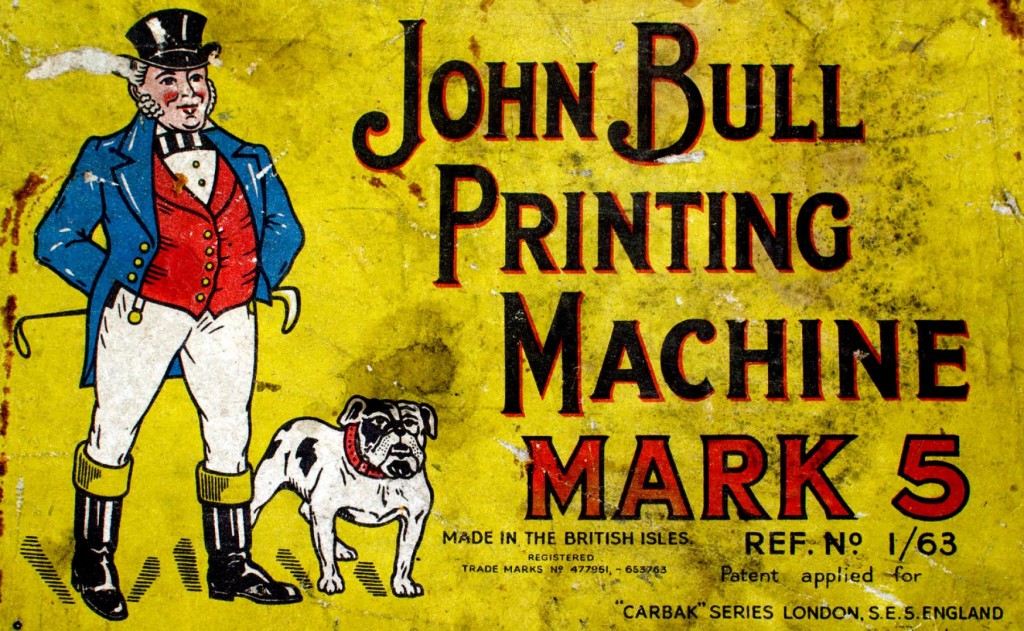
Во время наполеоновских войн Джон Булль стал национальным символом свободы, верности королю и стране и сопротивления французской агрессии. Он был обычным обывателем, который в случае необходимости сразился бы с Наполеоном голыми руками.
К 1800-м годам он считался более напористой фигурой и во внутренней политике, готовой критиковать королевскую семью и правительство, давая голос тем, кто не участвует в традиционном политическом процессе.
Джон Булл стал настолько известен, что его имя часто появлялось в книгах, пьесах, периодических изданиях, а также в качестве торговой марки или товарного знака. Хотя Джон Булл часто использовался во время Второй мировой войны, с 1950-х годов его видели реже.
Призывной плакат времен Первой мировой войны
Джон Булл до сих пор пользуется любовью многих англичан. Как Дядя Сэм является культовым представителем Соединенных Штатов, так и Джон Булль является олицетворением характера англичан: честный, щедрый, прямолинейный, с жизнелюбием и готовый встать и бороться за то, во что он верит.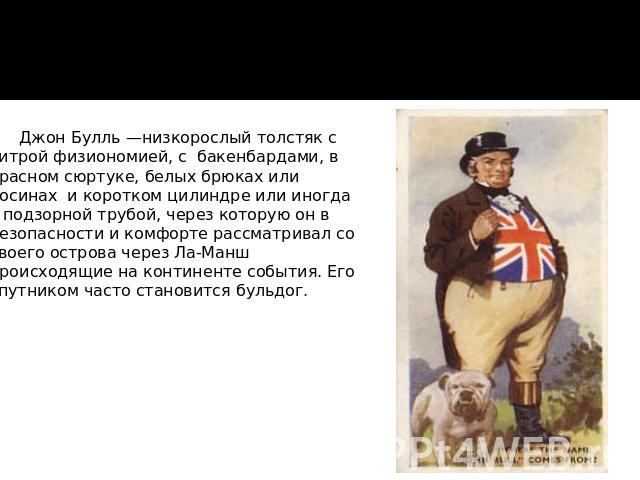
Footnote:
В реальной жизни жил Джон Булл, один из самых выдающихся английских клавишников своего времени. Джон Булл (1562–1628) находился на службе у королевы Елизаветы I, прежде чем укрыться в Нидерландах, чтобы избежать различных обвинений, в том числе в прелюбодеянии, выдвинутых против него в Англии. Он был известен как органист и вирджиналист.*
Бык написал клавишные композиции, самая известная из которых — The King’s Hunt. Он также считается автором песни «Боже, храни короля» — предполагается, что мелодия была найдена среди его бумаг после его смерти.
*Virginal – форма клавишного инструмента с механизмом для защипывания, а не удара молотком по струнам.

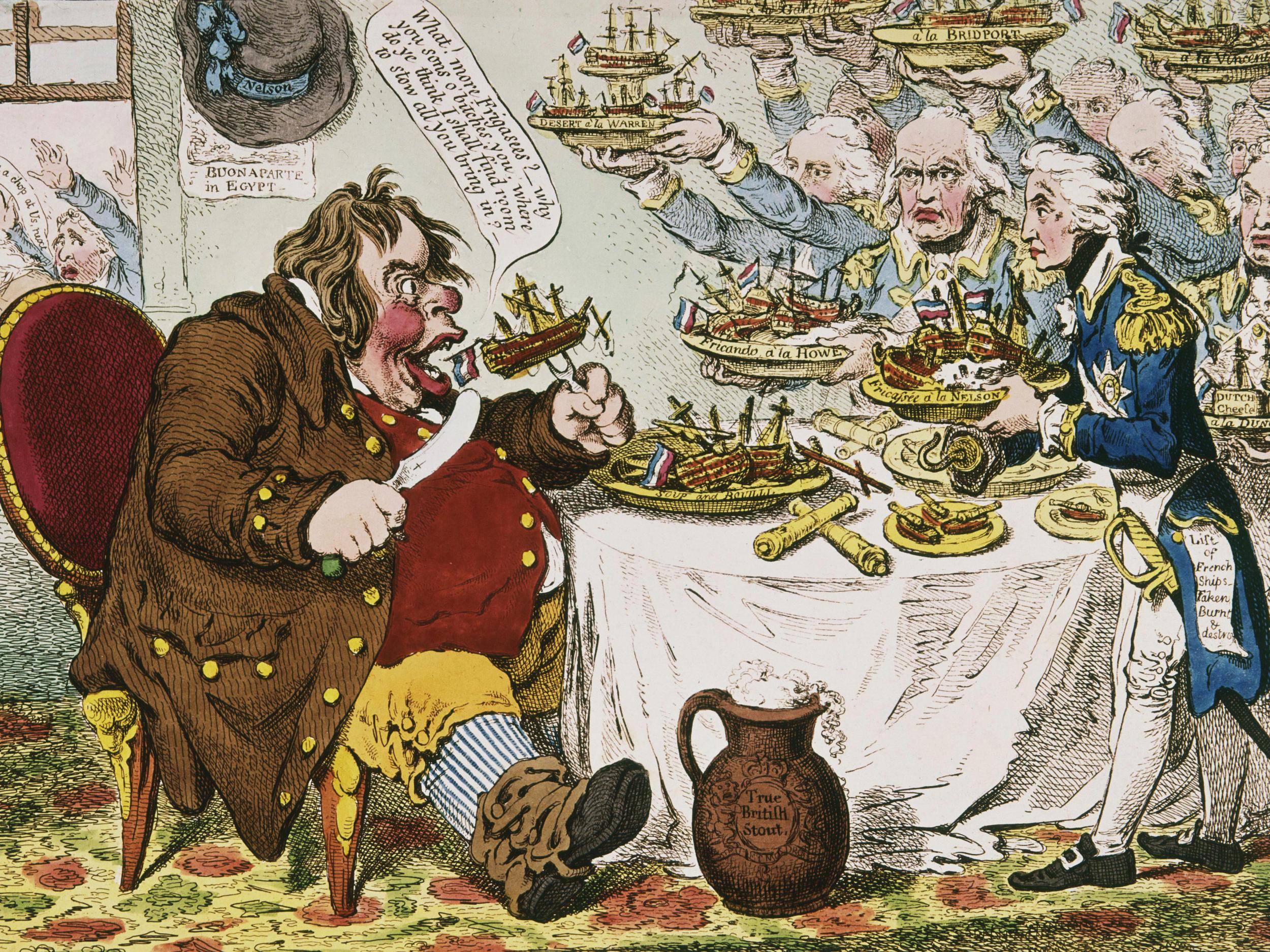
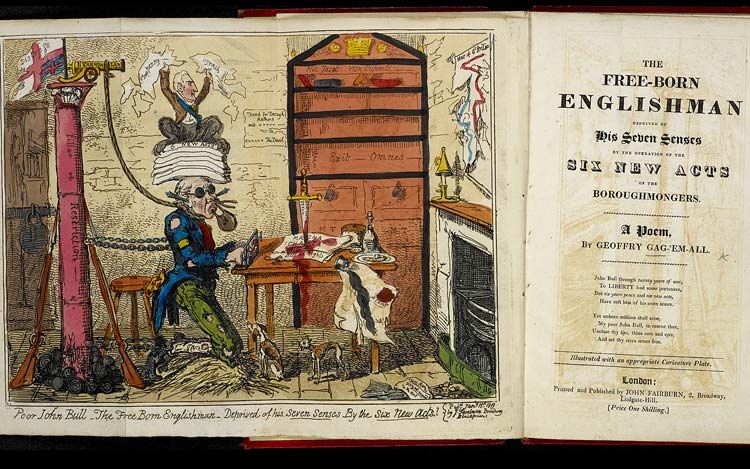 Они появились в том виде, в каком мы их знаем, примерно в середине девятнадцатого века как стереотипы высоких викторианских карикатуристов. До недавнего времени большинство историков относились к этим национальным символам как к само собой разумеющимся орнаментам или фиксированным, неизменным иконам. Такая интерпретация гарантирует, что современный зритель не поймет той решающей роли, которую эти сатирические фигуры сыграли в росте английского патриотизма и шовинизма, в развитии национальных и региональных представлений и стереотипов о самом себе, в политическом диалоге второй половины XIX века. восемнадцатого века. При рассмотрении в рамках визуальной хроники их метаморфозы позволяют нам не только сосредоточиться на росте патриотизма, отмеченном столь многими в конце восемнадцатого века, но и проследить сдвиги в общественном мнении.
Они появились в том виде, в каком мы их знаем, примерно в середине девятнадцатого века как стереотипы высоких викторианских карикатуристов. До недавнего времени большинство историков относились к этим национальным символам как к само собой разумеющимся орнаментам или фиксированным, неизменным иконам. Такая интерпретация гарантирует, что современный зритель не поймет той решающей роли, которую эти сатирические фигуры сыграли в росте английского патриотизма и шовинизма, в развитии национальных и региональных представлений и стереотипов о самом себе, в политическом диалоге второй половины XIX века. восемнадцатого века. При рассмотрении в рамках визуальной хроники их метаморфозы позволяют нам не только сосредоточиться на росте патриотизма, отмеченном столь многими в конце восемнадцатого века, но и проследить сдвиги в общественном мнении. Ее зверинец, особенно лев, бульдог или мастиф, являются потомками средневековой символической традиции. Эти значки были впервые использованы английской элитой в конце 1500-х годов в гербовых книгах, на масках и на монетах, чтобы вдохновить династическую и национальную лояльность. Джон Булл появился в начале восемнадцатого века. К 1780-м годам художники и писатели изображали семью Джона Булла и множество животных на политических репродукциях, чтобы символизировать нацию и национальный характер. Чаще всего они становились жертвами тирании, партийной политики, политики правительства или иностранных держав. Их внешний вид менялся в зависимости от их роли. Только после наполеоновских войн художники, публицисты, пропагандисты, а позже и рекламщики превратили Джона Буля в флегматичного деревенского помещика, воплощение буржуазного английского и британского характера, и в то же время превратили Британию в матронную греко-римскую богиню, визуальное 17 представление национальных добродетелей.
Ее зверинец, особенно лев, бульдог или мастиф, являются потомками средневековой символической традиции. Эти значки были впервые использованы английской элитой в конце 1500-х годов в гербовых книгах, на масках и на монетах, чтобы вдохновить династическую и национальную лояльность. Джон Булл появился в начале восемнадцатого века. К 1780-м годам художники и писатели изображали семью Джона Булла и множество животных на политических репродукциях, чтобы символизировать нацию и национальный характер. Чаще всего они становились жертвами тирании, партийной политики, политики правительства или иностранных держав. Их внешний вид менялся в зависимости от их роли. Только после наполеоновских войн художники, публицисты, пропагандисты, а позже и рекламщики превратили Джона Буля в флегматичного деревенского помещика, воплощение буржуазного английского и британского характера, и в то же время превратили Британию в матронную греко-римскую богиню, визуальное 17 представление национальных добродетелей.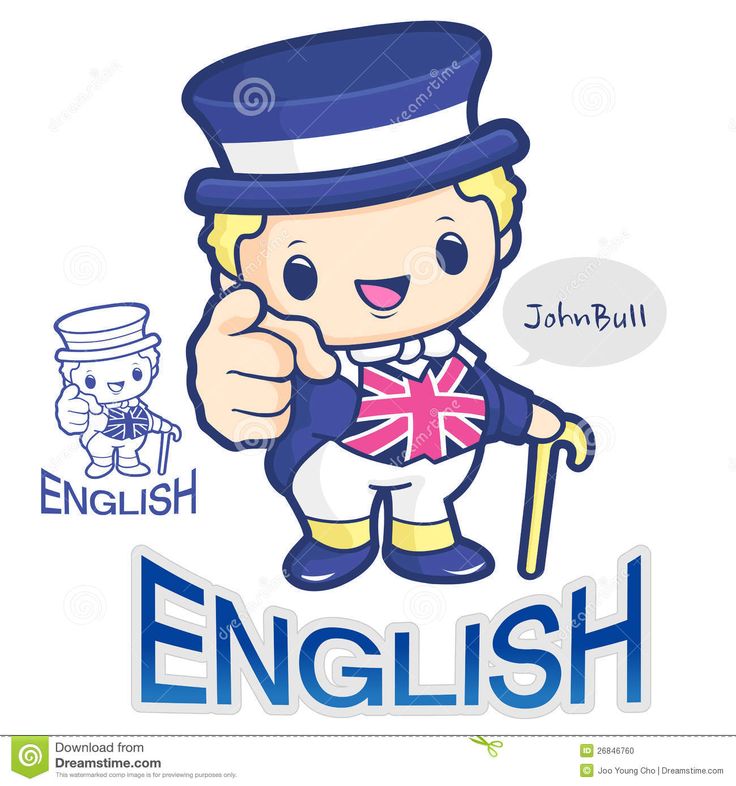 Более внимательное изучение этого глоссария переходных символов в их историческом контексте дает один из ключей к пониманию развития позднегрузинской и викторианской политической культуры и английского, а затем и британского образа самого себя. Изменение внешнего вида этих национальных икон свидетельствует о переходе от грузинского недовольства к высокому викторианскому самодовольству. «Грузинская дерзость, — заметил Дрейпер Хилл в мистере Гилрее, карикатуристе, — уступила место викторианскому достоинству, когда мусор оказался более ходким товаром». Точно так же их трансформация дает некоторые подсказки относительно того, как и почему истеблишмент присвоил эти образы для собственного использования, как, например, когда Свобода была реконструирована во Франции или Америке в патриотическую женщину-воительницу.
Более внимательное изучение этого глоссария переходных символов в их историческом контексте дает один из ключей к пониманию развития позднегрузинской и викторианской политической культуры и английского, а затем и британского образа самого себя. Изменение внешнего вида этих национальных икон свидетельствует о переходе от грузинского недовольства к высокому викторианскому самодовольству. «Грузинская дерзость, — заметил Дрейпер Хилл в мистере Гилрее, карикатуристе, — уступила место викторианскому достоинству, когда мусор оказался более ходким товаром». Точно так же их трансформация дает некоторые подсказки относительно того, как и почему истеблишмент присвоил эти образы для собственного использования, как, например, когда Свобода была реконструирована во Франции или Америке в патриотическую женщину-воительницу.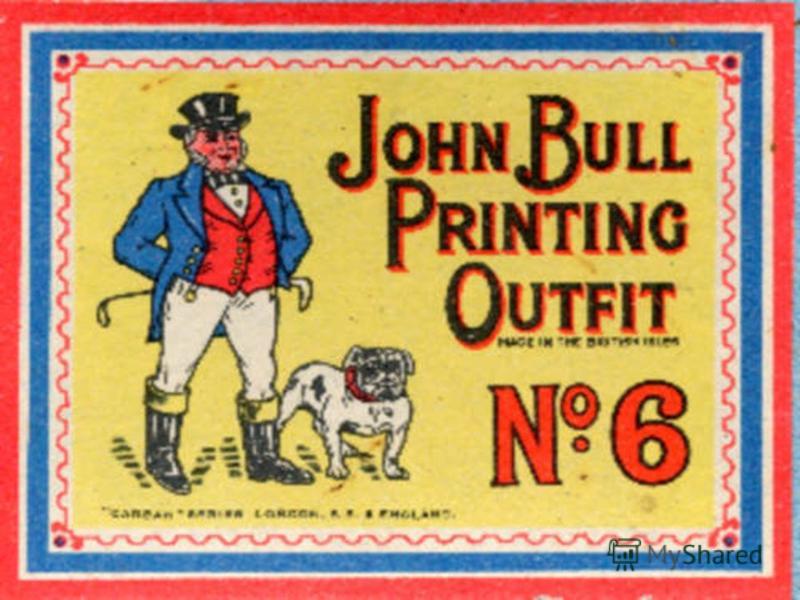 Золотой век английской сатирической печати — эпоха Хогарта, Гилрея, Роулендсона и Круикшенка — является результатом творчества художников и печатников, вдохновленных динамичной политической культурой и народным спросом, творчески соединивших две эмблемы, символические традиции: в значительной степени развитые в Ренессанс и карикатура — особая индивидуальная техника изобразительной сатиры эпохи барокко, завезенная из Италии в XVIII в.
Золотой век английской сатирической печати — эпоха Хогарта, Гилрея, Роулендсона и Круикшенка — является результатом творчества художников и печатников, вдохновленных динамичной политической культурой и народным спросом, творчески соединивших две эмблемы, символические традиции: в значительной степени развитые в Ренессанс и карикатура — особая индивидуальная техника изобразительной сатиры эпохи барокко, завезенная из Италии в XVIII в. В 1750-х годах лорд Джордж Тауншенд нападал на своих противников с помощью карикатур, распространяя их среди своих друзей и потенциальных союзников.
В 1750-х годах лорд Джордж Тауншенд нападал на своих противников с помощью карикатур, распространяя их среди своих друзей и потенциальных союзников. Художники регулярно перерабатывали национальные символы, играя с расширяющейся знаковой лексикой, отвечая их популярности и веяниям времени.
Художники регулярно перерабатывали национальные символы, играя с расширяющейся знаковой лексикой, отвечая их популярности и веяниям времени. В начале 1600-х годов Британия материализовалась как визуальный образ, который, лишь немного изменившись, сохранился до наших дней. Ее благородный дух и ценности восхвалялись в символических книгах и на масках при дворах Стюартов, Якова I и Карла I. Голландские медали во время их пропагандистской кампании середины семнадцатого века против Англии изображали Британию в нелестных, даже оскорбительных позах. Во время правления Карла Второго Британия вернула британским деньгам лицо, которое якобы принадлежало одной из многочисленных фавориток короля, Фрэнсис Стюарт, герцогине Ричмондской. Британия сидела с копьем в правой руке, оливковой ветвью или веткой в левой, опираясь левым предплечьем на щит, украшенный крестом Святого Георгия и салтиром Святого Андрея или, реже, королевским гербом. Как Минерва или Афина Паллада Британии, она навсегда осталась на британских монетах. Во время правления Георга III копье Британии сменил трезубец Нептуна, и она приобрела шлем с перьями.
В начале 1600-х годов Британия материализовалась как визуальный образ, который, лишь немного изменившись, сохранился до наших дней. Ее благородный дух и ценности восхвалялись в символических книгах и на масках при дворах Стюартов, Якова I и Карла I. Голландские медали во время их пропагандистской кампании середины семнадцатого века против Англии изображали Британию в нелестных, даже оскорбительных позах. Во время правления Карла Второго Британия вернула британским деньгам лицо, которое якобы принадлежало одной из многочисленных фавориток короля, Фрэнсис Стюарт, герцогине Ричмондской. Британия сидела с копьем в правой руке, оливковой ветвью или веткой в левой, опираясь левым предплечьем на щит, украшенный крестом Святого Георгия и салтиром Святого Андрея или, реже, королевским гербом. Как Минерва или Афина Паллада Британии, она навсегда осталась на британских монетах. Во время правления Георга III копье Британии сменил трезубец Нептуна, и она приобрела шлем с перьями.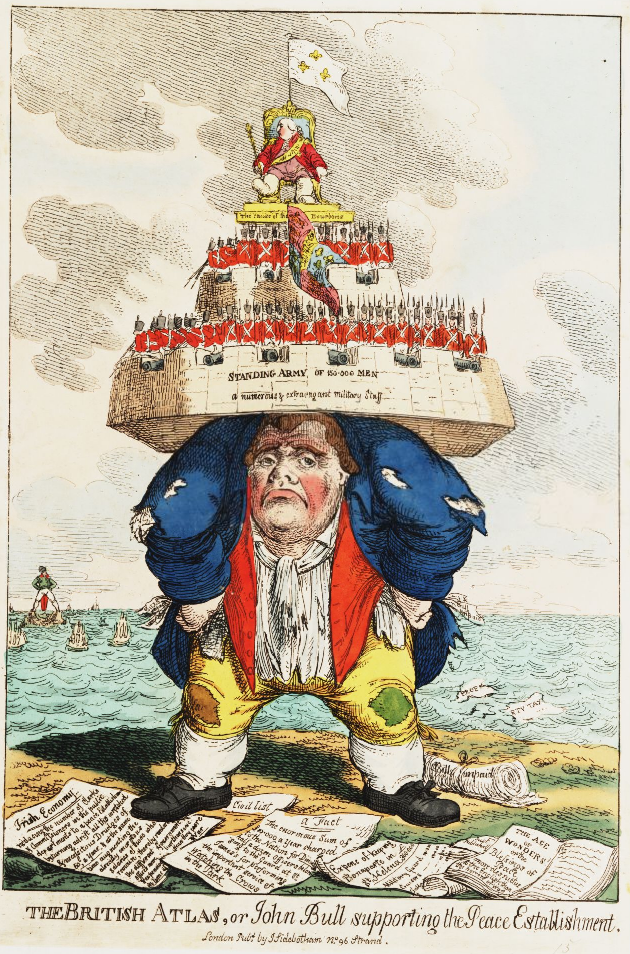 Она воплощала в себе многочисленные Добродетели, особенно те, которые связаны с национальной и общественной жизнью: патриотизм, честность, самоотверженность, дисциплину, простоту. Она также гарантировала английские свободы, особенно Свободу, женское олицетворение свободного народа. Свобода была нарисована в виде девушки с мягкими чертами лица, в классической тунике или простом платье, с непокрытой головой, отличающейся от других традиционных женских аллегорических фигур шапкой свободы на шесте. Чаще всего Британию изображали как невинного опекуна, над которым издевались, оскорбляли, даже изнасиловали или замучили.
Она воплощала в себе многочисленные Добродетели, особенно те, которые связаны с национальной и общественной жизнью: патриотизм, честность, самоотверженность, дисциплину, простоту. Она также гарантировала английские свободы, особенно Свободу, женское олицетворение свободного народа. Свобода была нарисована в виде девушки с мягкими чертами лица, в классической тунике или простом платье, с непокрытой головой, отличающейся от других традиционных женских аллегорических фигур шапкой свободы на шесте. Чаще всего Британию изображали как невинного опекуна, над которым издевались, оскорбляли, даже изнасиловали или замучили.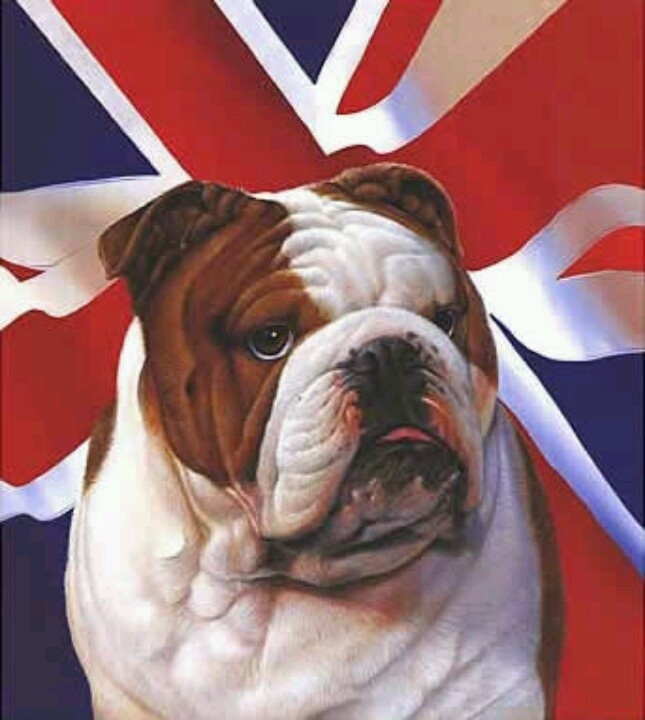 С той эпохи художники, писатели, драматурги, поэты и публицисты смешивали легендарных героинь, классические символы, правящих королев и совсем недавно женщину-премьер-министра с героическими идеалами, которые они считали подходящими и необходимыми для своих целей. В конце концов, пропаганда стала, как эффективно демонстрирует Марина Уорнер в « Памятниках и девах» , «главным театром деятельности Британии».
С той эпохи художники, писатели, драматурги, поэты и публицисты смешивали легендарных героинь, классические символы, правящих королев и совсем недавно женщину-премьер-министра с героическими идеалами, которые они считали подходящими и необходимыми для своих целей. В конце концов, пропаганда стала, как эффективно демонстрирует Марина Уорнер в « Памятниках и девах» , «главным театром деятельности Британии».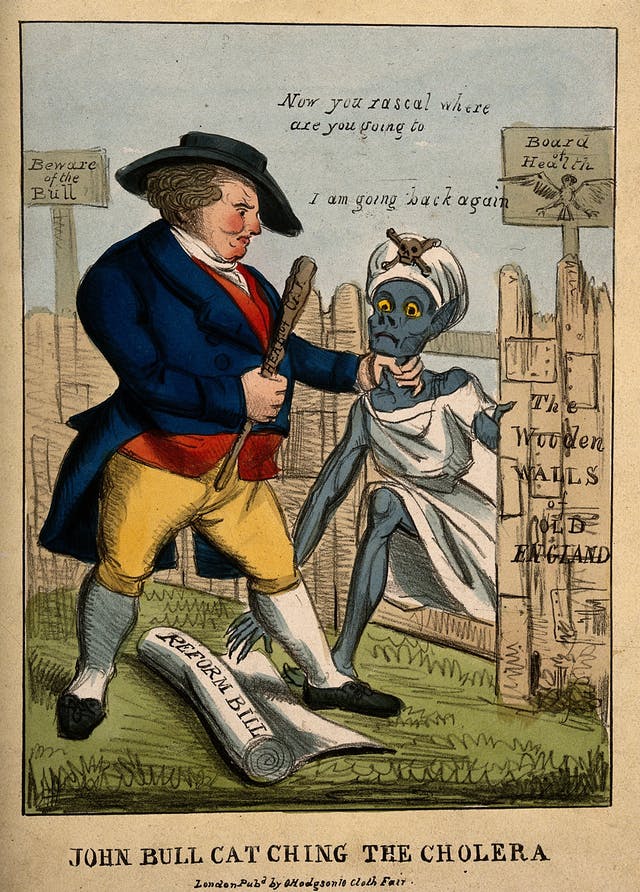 . .] Джон был быстр и очень хорошо разбирался в своем деле, но никто не был более небрежным в изучении своих Счетов или более обманутым Партнерами, Учениками или Слугами: это было вызвано тем, что он был хорошим компаньоном, любил свою бутылку и свои развлечения. ; ибо, по правде говоря, ни один человек не содержал лучшего дома, чем Джон, и не тратил свои деньги более щедро.
. .] Джон был быстр и очень хорошо разбирался в своем деле, но никто не был более небрежным в изучении своих Счетов или более обманутым Партнерами, Учениками или Слугами: это было вызвано тем, что он был хорошим компаньоном, любил свою бутылку и свои развлечения. ; ибо, по правде говоря, ни один человек не содержал лучшего дома, чем Джон, и не тратил свои деньги более щедро.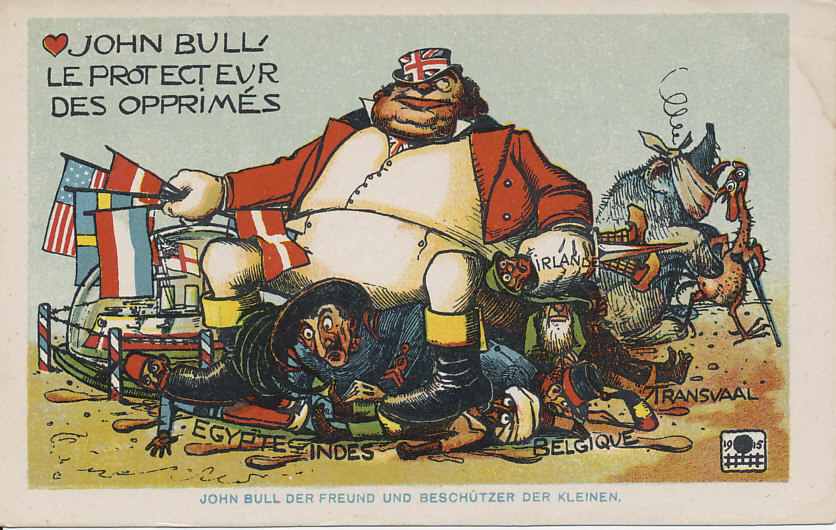 А бедный Бык редко проявляет агрессивность. Хилл отметил, что: «Преданный патриот, он существует в первую очередь как объект для преследования и эксплуатации». Точно так же Дороти Джордж на основе своего каталога грузинской визуальной сатиры пришла к выводу, что карикатуристы двойственно относились к Джону Буллу, потому что в Британии все еще продолжался «тонкий процесс демократизации». Поскольку Булл не был стандартизирован, она пришла к выводу, что у него был двойной образ: «типичный англичанин (несущий бремя, который ворчит и платит)» и «рупор коллективного мнения». После 1792 Джон Булл служил в мультфильмах солдатом и матросом против Наполеона. Бык как «неотесанный мужлан» олицетворял наивность, проницательность и злобность. В то же время, по мнению доктора Джорджа, он представлял собой «прекрасное олицетворение меняющегося умственного климата и меняющихся мнений», что часто ставило его «вне правящего класса».
А бедный Бык редко проявляет агрессивность. Хилл отметил, что: «Преданный патриот, он существует в первую очередь как объект для преследования и эксплуатации». Точно так же Дороти Джордж на основе своего каталога грузинской визуальной сатиры пришла к выводу, что карикатуристы двойственно относились к Джону Буллу, потому что в Британии все еще продолжался «тонкий процесс демократизации». Поскольку Булл не был стандартизирован, она пришла к выводу, что у него был двойной образ: «типичный англичанин (несущий бремя, который ворчит и платит)» и «рупор коллективного мнения». После 1792 Джон Булл служил в мультфильмах солдатом и матросом против Наполеона. Бык как «неотесанный мужлан» олицетворял наивность, проницательность и злобность. В то же время, по мнению доктора Джорджа, он представлял собой «прекрасное олицетворение меняющегося умственного климата и меняющихся мнений», что часто ставило его «вне правящего класса».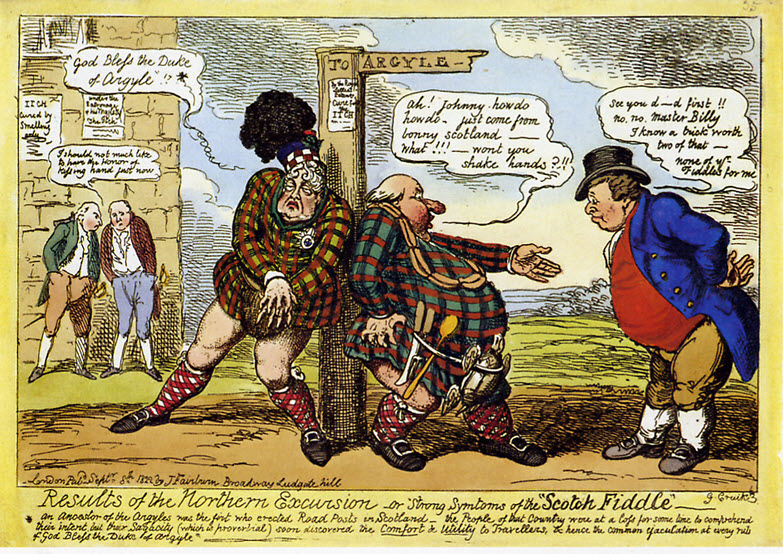 Как отметил Хью Каннингем в «Встанет ли настоящий Джон Булл, пожалуйста», к 1770-м годам патриотизм, определенный в Словаре доктора Джонсона (издание 1755 г.) как «тот, чьей главной страстью является любовь к своей стране», был захвачен Английский радикально такой, как Уилкс. «Патриот, — писал Каннингем, — стал кем-то, чьей главной страстью было отстаивание прав свободнорожденного англичанина». Теперь можно понять, почему в 1775 г. Джонсон (прообраз самого Джона Булля) ворчал Босуэллу, что «патриотизм — последнее прибежище негодяев».
Как отметил Хью Каннингем в «Встанет ли настоящий Джон Булл, пожалуйста», к 1770-м годам патриотизм, определенный в Словаре доктора Джонсона (издание 1755 г.) как «тот, чьей главной страстью является любовь к своей стране», был захвачен Английский радикально такой, как Уилкс. «Патриот, — писал Каннингем, — стал кем-то, чьей главной страстью было отстаивание прав свободнорожденного англичанина». Теперь можно понять, почему в 1775 г. Джонсон (прообраз самого Джона Булля) ворчал Босуэллу, что «патриотизм — последнее прибежище негодяев».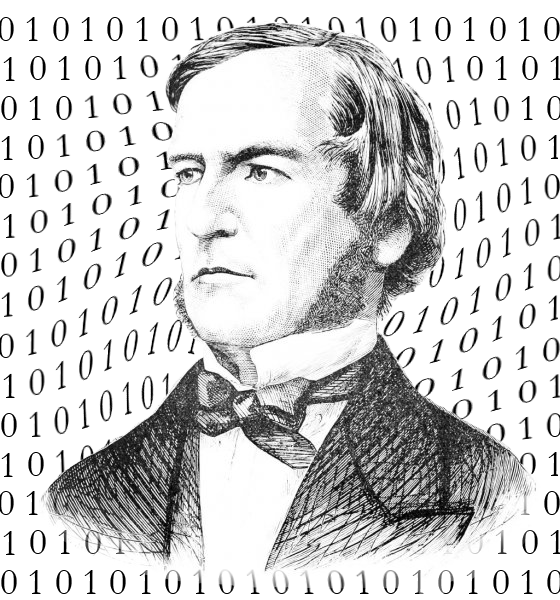 Таким образом, пухлый англичанин был в конечном итоге лучше физически и умственно, чем «порабощенный» француз. Хотя Бык обычно был сыт, иногда побеждал и, безусловно, был более благословлен, чем «порабощенный» санкюлот, он редко излучал самоуверенность, так как еще не был убежден в собственной силе и влиянии.
Таким образом, пухлый англичанин был в конечном итоге лучше физически и умственно, чем «порабощенный» француз. Хотя Бык обычно был сыт, иногда побеждал и, безусловно, был более благословлен, чем «порабощенный» санкюлот, он редко излучал самоуверенность, так как еще не был убежден в собственной силе и влиянии.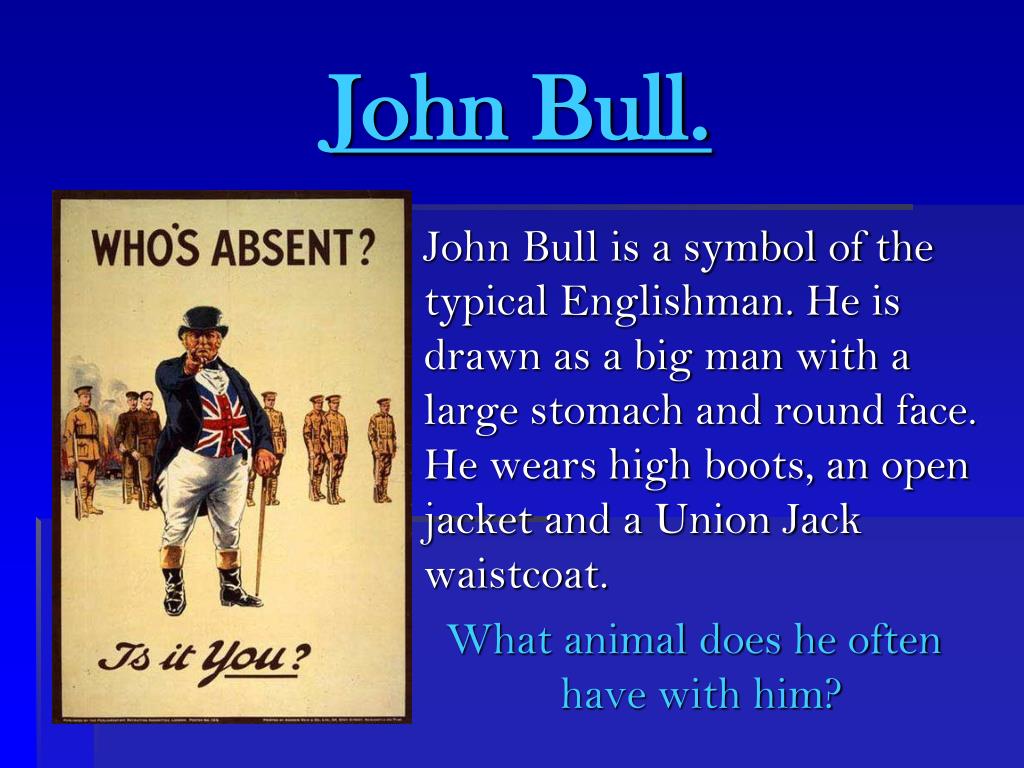
 Британия Пиявки все больше и больше превращалась в абстракцию, матронную женскую боевую секиру, символ патриотических добродетелей, а не коллективную волю или национальную личность, связанные с Джоном Буллем. В некотором смысле она олицетворяла идеальную викторианскую женщину, а также национальные идеалы, и ее все чаще ассоциировали (или путали?) с королевой Викторией.
Британия Пиявки все больше и больше превращалась в абстракцию, матронную женскую боевую секиру, символ патриотических добродетелей, а не коллективную волю или национальную личность, связанные с Джоном Буллем. В некотором смысле она олицетворяла идеальную викторианскую женщину, а также национальные идеалы, и ее все чаще ассоциировали (или путали?) с королевой Викторией.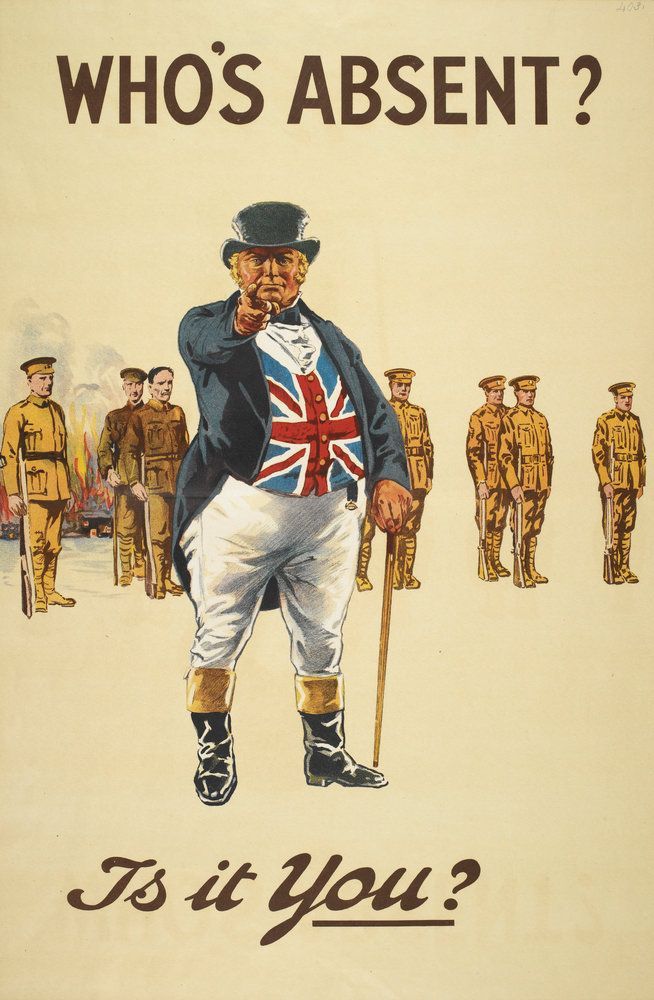 Ее манеры и поведение подняли ее на уровень, напоминающий аллегории и абстракции, изображенные веками ранее в книгах эмблем. Викторианская приличия среднего класса и воинствующий национализм превратились в сестер Британии: Истину, Храбрость и Утрату. Дэвид Лоу утверждал, что Тенниел завербовал не только Британию, но и всю ее семью в «постоянный штат, так сказать, Cartooning». В мультяшном мире Тенниела Лоу в свои 19В эссе 42 «Британские карикатуристы» отмечалось:
Ее манеры и поведение подняли ее на уровень, напоминающий аллегории и абстракции, изображенные веками ранее в книгах эмблем. Викторианская приличия среднего класса и воинствующий национализм превратились в сестер Британии: Истину, Храбрость и Утрату. Дэвид Лоу утверждал, что Тенниел завербовал не только Британию, но и всю ее семью в «постоянный штат, так сказать, Cartooning». В мультяшном мире Тенниела Лоу в свои 19В эссе 42 «Британские карикатуристы» отмечалось: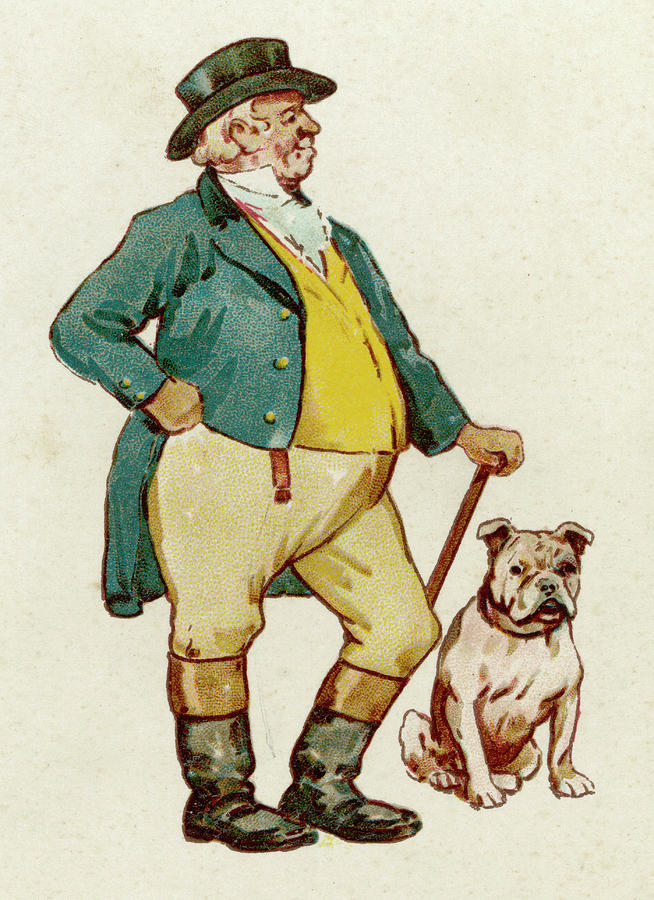 Оба теперь отождествлялись с Великобританией на пике ее промышленной и имперской мощи. Пока Британия продолжала господствовать над морем, эти национальные символы, наряду со Львом и Бульдогом, воспринимались как положительные образы. Как воины за правое дело они олицетворяли имперскую Великобританию. Однако у них не было своих соперников или критиков.
Оба теперь отождествлялись с Великобританией на пике ее промышленной и имперской мощи. Пока Британия продолжала господствовать над морем, эти национальные символы, наряду со Львом и Бульдогом, воспринимались как положительные образы. Как воины за правое дело они олицетворяли имперскую Великобританию. Однако у них не было своих соперников или критиков.
Leave A Comment